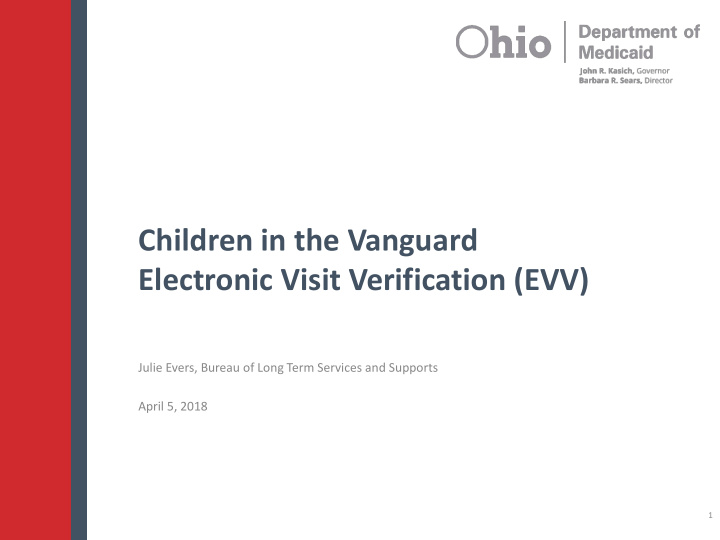



Children in the Vanguard Electronic Visit Verification (EVV) Julie Evers, Bureau of Long Term Services and Supports April 5, 2018 1
What is EVV? • Electronic Visit Verification (EVV) is a tool for electronically capturing point-of- service information for certain home and community-based services. » Sandata Technologies is the ODM vendor » Near real-time processing capability » GPS-based system with telephony and manual visit entry as alternative data collection methods 2
Why do we need it? • Congress established requirements for all states to use an EVV system, in accordance with the 21 st Century Cures Act. Personal Care Services must use EVV by January 1, 2019 Home Health Care Services must use EVV by January 1, 2023 Failure to meet these deadlines results in reduction of Federal Financial Participation for those services 3
21 st Century Cures Act Requirements • “Electronic Visit Verification System” means, with respect to personal care services or home health care services, a system under which visits conducted as part of such services are electronically verified with respect to: » The type of service performed; » The individual receiving the service; » The date of the service; » The location of service delivery; » The individual providing the service; and » The time the service begins and ends. 4
What are the benefits? • ODM is adopting an EVV system to promote two key outcomes: » Promote quality outcomes for individuals (Quality of Care) • Greater opportunity for enhanced care coordination and data sharing » Reduce billing errors and improve payment accuracy (Program Integrity) • Electronically verifies that a caregiver is physically present for a visit 5
What Services are included in Phase 1? • State Plan Home Health Aide • State Plan Home Health Nursing • State Plan RN Assessment • Private Duty Nursing (PDN) • Ohio Home Care Waiver Nursing • Ohio Home Care Waiver Personal Care Aide • Ohio Home Care Waiver Home Care Attendant 6
EVV Stakeholders - Collaboration • Individuals • Provider Community • Trading Partners and Billers • Partner Agencies • Managed Care Plans 7
Getting the Message Out • Sharing the message early to enable a smooth Go Live. • Individuals (Recipients) » Stakeholder Meetings » Written Correspondence » Consumer groups » Introductory video » Webinars • Providers » Stakeholder meetings » Correspondence » Interactive Voice Response (IVR) » Training 8
How will visit information be collected? • Confidential visit information is collected through the use of a GPS enabled Mobile Device, used to sign in and sign out. • Alternate data collection systems must implement GPS before January 1, 2019 • Every EVV System must have two backup methods for collecting data. 9
Why a Mobile Device? • The mobile device allows capture of visit data wherever services are provided. • Provides flexibility to consumer that a landline or fixed device in the home does not offer • Only needs to go with the individual when the visit will start or end away from home 10
GPS • Captured only at the start of the visit and the end of the visit • Matches to any address connected to the individual by the provider in the Sandata system • 1000 foot geo fence 11
Cameras and Microphone • Cameras are used for device configuration and disabled before the device is sent to an individual. • Microphone is only active when the record button has been pushed to capture the verification of service delivery 12
Next In Phase 1 • Use visit information in claims adjudication process • Eliminate 90 day exception • Offer an application that can be used on a personal mobile device owned by the provider or direct care worker as an alternative to the EVV mobile device • Target implementation date is July 2018 13
Phase 2 • Implementation Target Date in Fall 2018 • Includes services in PASSPORT, Level One, Individual Options and SELF waivers • Includes Managed Care (Traditional and MyCare Ohio) » MCPs have been part of the EVV build from the beginning. » Managed Care Plans will use fee for service system 14
Recommend
More recommend